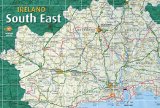Travel guide to Ireland's south east
Pearls of Ireland
![]() HOLIDAY MAGAZINE
HOLIDAY MAGAZINE
Raise your glasses to a land of warm welcomes, chilled stout and spectacular scenery, as Faith Leigh discovered on the latest of her forays into the Emerald Isle.
As my plane landed at Cork airport, I was looking forward to seeing the changes a couple of months on to the redevelopment; having a chance to admire the new water features and the fabulously coloured tropical fish that ease traveller’s stress as they wait for their luggage in the arrivals hall. Then I was hit by one of life’s little ironies… The airport is spending a fortune to fulfil its slogan of being the small airport with the big heart – friendly and approachable – but it has also become so efficient that as I walked into the baggage reclaim area there was my suitcase waiting for me, so straight through without a chance to contemplate my tropical friends.
Apparently its stated aim is to re-unite travellers with their luggage in a maximum time of twenty minutes from landing. I wish most of the other airports I use could be that good.
Cork was the perfect gateway to the next stage of my Irish Odyssey, a circular perambulation around the counties of Waterford, Wexford, Kilkenny and Tipperary. For those in a hurry to arrive, the N25 is a great road to Waterford which, will cut the journey time down to under two hours. Being of a more leisurely frame of mind, however, I opted to turn off just after Dungarvan and take the scenic and coastal route which continues through to Passage East. Leo Mannion had done me proud as always with my rental car, offering me a very stylish Rover 400 which combines excellent comfort and easy driving with remarkable fuel economy.
In Waterford, The Granville, one of Waterford oldest hotels, which dates back to the early 1800’s and sits majestically on the banks of the River Suir in the heart of the city, provided a delightful base for my explorations.
First stop, of course, us the tourist attraction synonymous with the city – the Waterford Crystal Visitor Centre. Here it is possible to watch the fascination process of glass blowing, engraving and cutting as craftsmen pursue what is a centuries old tradition that has changed little over time.
The amazing galleries contain examples of the most stunning works of these skilled workers; everything from a full-sized grandfather clock, all in cut glass, to the most modern of presentation crystal and chandeliers. While gawking unashamedly at all these marvellous pieces I couldn’t possibly afford (unless I win the Lottery of course). I was conscious of holding my arms and handbag more tightly to my sides than I had ever done before in sheer terror of what a breakage would cost!
Having slaked my hunger and thirst for beauty, almost to the point of overindulgence, I decided it was time to seek the answer to a gastronomic equivalent. The gourmet, as in most Irish cities is well catered for with a raft of choice. For me however, the ultimate temptation had to be The Wine Vault, mastered presided over by “Chevalier du Tastevin” David Dennison. Spread over two floors, history is evident here again with the remains of a 15th century town house forming the wall behind the bar and 18th century vaulted cellars in the basement making an unusual and intimate dining venue.
David’s wine selection is undoubtedly one that every Epicurean will appreciate. Obviously not everyone will be into some of the rare, classic burgundies and clarets that he offers at prices which, while quite reasonable for Grand Crus Classes, would leave the average mortals credit card quite severely dented. There is however, an eclectic and interesting range for those of the more modest means and he is delighted to “ walk” one through what is available, many of which are offered by the glass. This makes it possible some excellent wines, particularly appropriate to accompany the delicious food that is served here. I was particularly impressed with the hors d’oevre of half a dozen local oysters, baked, each with a different topping. This made an unusual dish with a particularly interesting combination of tastes.
One of the best ways to get to know Waterford is to join one of Jack Burtchaell’s fascinating walking tours of the city, which run twice daily from the Granville Hotel. Starting with the City’s founding by the Viking’s over a thousand years ago, he brings history to life with a fund of esoteric stories and intelligence that amuse while they inform.
I don’t think I will ever forget such facts as that the first frog in Ireland was released in Waterford, or that the father, so to speak, of much of the city’s architecture, including both Protestant and Catholic Cathedrals (and that’s a first too, that they were both designed by the same man), managed despite all his hard work to sire twenty-two children as well! Apparently, too, at one point in the 17th century when all the merchant princes departed for pastures new in Europe as a result of Cromwell’s depredations, Waterford City was actually put up for sale, but there were no buyers… hmm, wonder what it would have been like to “own” a city?
Leaving Waterford I continued east for my next stop, Wexford. I had been advised again to take the less busy route using the ferry from Passage East to Ballyhack and in the process discovered the origin of the phrase “by hook or by Crook”. On one side of the River Suir estuary is Crook and on the other side is Hook Head ( with fabulous views on a good day: follow the signs for the Ring of Hook to enjoy these)from which there is the option again on a fairly fast route or the coastal delights of Duncannon, Kilmore Quay and up through Rosslare Harbour.
However, one of the unmissable stops, was at the Irish National Heritage Park. This 35 acre outdoor park welcomes the visitor with a fascinating audio-visual presentation, following which one can wander round fourteen sites which depict settlements in Ireland from 7000 BC., to the arrival of the Normans in the 12th century. Sixteen sites have been lovingly re-constructed from a Mesolithic camp site through Neolithic dolmen, Bronze Age stone circle to the Celtic and early Christian Ringfort, Water Mill, Viking boat house and many other.
There is no doubt that Wexfordians are extremely proud of their heritage and what their county has to offer the visitor as I discovered at dinner that night with Dara Ward, the region’s marketing executive and my host, Ursula Sinnott of the first-rate Talbot Hotel overlooking the quay. Their boundless enthusiasm kept me soundly entertained and informed until we had managed to empty out both the restaurant and the bar! The town also boats both ancient and modern, with latter day shops nestling next to the old town which is full of interesting craft shops and galleries. Other side visits while based here with some time to spend, could include the famous Tintern Abbey, Duncannon Fort and as many castle as anyone could want.
For me though the highlight of seeing this area had to be as I left the town of New Ross where I encountered one of the most amazing construction feats around today.
Here a group of dedicated craftsmen is painstakingly building from scratch – by hand using all the traditional methods – a replica of one of the original tall ships that plied between Ireland and Newfoundland in the famine times of the 1840’s.
“The Dunbrody” is an amazing sight – a 176 foot long, 258 tonne, two decked three-masted barque. I was fortunate enough to be taken under the wing of Tony McLoughlin, a strapping moustachioed gentleman who would have, I am sure looked absolutely at home commanding the original ship, and who was an absolute mine of information about her namesake’s construction. He also ably demonstrated just how much love and dedication the forty craftsmen involved in the reconstruction are pouring into their labours – I felt for him as he described the intensive labour filling every space between the massive ribs of Irish Oak with hemp and caulking them with oakum and hot pitch.
On once more, through a scenic route that meandered gently through the countryside along the River Nore, I passed through one of the prettiest riverside villages – Inistioge – with delightful river walks and flower surrounded pubs. A few stops at unusual craft and potteries around Bennetsbridge were other interesting diversions northwards that took me eventually to Kilkenny, described as ‘the creative heart of Ireland.’
This title has been achieved through two major influences. In the 1970’s the Kilkenny Design Workshops were founded offering practitioners of traditional crafts of all kinds from weaving, pottery leather and knitwear to jewellery, ceramics and fine arts, the chance to set up their own workshops, display their creations and encourage students to learn the skills. Additionally the Crafts Council of Ireland set up its headquarters here in 1998, and has brought it all together in the lovely stone buildings just across the road from the towns famous castle.
The Newpark Inn, my base in Kilkenny, was the most modern of the places I stayed at on my visit. A light spacious, Scandinavian style atrium provided an elegant welcome, but I regretted the lack of time meant I could no take full advantage of the hotel’s exceptional leisure centre with its 52 ft swimming pool, sauna, jacuzzi, steam room and gym!. Well at least I had the best of intentions in the light of all the excellent Irish cuisine I was consuming, not least in the restaurant here, but we all know what happened to good intentions.!
My guide to the city was the ebullient Pat Nolan of the local Tourist Office who gave me a whistle stop tour of the two opposing poles that are the heart of Irish culture - the pubs and churches. I was particularly taken with the magnificent stained glass in the Black Abbey; both the incredible fifteen panelled west window best viewed as the sun hits it at dawn and its modern counterpart with the most vibrant almost day-glo colours which benefits from the afternoon light.
As with most of my Irish hosts, he turned out to be a master storyteller and imbued life and character into the wealth of historical facts he imparted. One can easily see how the Irish have become famous for waxing lyrical and what a delight it is to be able to soak up the atmosphere in the most personal way.
Once again, it was all too soon I had to move on and turn south-west towards my final call before returning to Cork and everyday life. Heading from Kilkenny county into Tipperary I made for Cashel Palace, built in 1739 by Archbishop Theophilus Bolton, with a most unusual red brick facing to the front and limestone to the rear.
As with all my meanderings around Ireland, I found that the counties of Waterford and Wexford, Kilkenny and Tipperary had enough to justify much longer stays that I was able to make; my list of things to do and see on future return visits when my time is my own and I am there for weeks rather than days grows longer and longer.
<< Return to Reviews page





